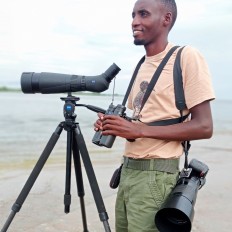Top species
- Udzungwa Partridge (Xenoperdix udzungwensis)
- Square-tailed Nightjar (Caprimulgus fossii)
- Crowned Hornbill (Lophoceros alboterminatus)
- Trumpeter Hornbill (Bycanistes bucinator)
- Moustached Tinkerbird (Pogoniulus leucomystax)
- African Golden Oriole (Oriolus auratus)
- Black-fronted Bushshrike (Telophorus nigrifrons)
- White-necked Raven (Corvus albicollis)
- Bar-throated Apalis (Apalis thoracica)
- Chapin's Apalis (Apalis chapini)
- Mrs. Moreau's Warbler (Scepomycter winifredae)
- Red-rumped Swallow (Cecropis daurica)
- Eastern Mountain Greenbul (Arizelocichla nigriceps)
- Fischer's Greenbul (Phyllastrephus fischeri)
- Southern Yellow White-eye (Zosterops anderssoni)
- White-eyed Slaty-Flycatcher (Melaenornis fischeri)
- Cape Robin-Chat (Cossypha caffra)
- White-browed Robin-Chat (Cossypha heuglini)
- White-starred Robin (Pogonocichla stellata)
- Swynnerton's Robin (Swynnertonia swynnertoni)
- Rubeho Akalat (Sheppardia aurantiithorax)
- Montane Double-collared Sunbird (Cinnyris ludovicensis)
- Moreau's Sunbird (Cinnyris moreaui)
- Bertram's Weaver (Ploceus bertrandi)
- Southern Brown-throated Weaver (Ploceus xanthopterus)
- Marsh Widowbird (Euplectes hartlaubi)
- Black-and-white Mannikin (Spermestes bicolor)
- Yellow-bellied Waxbill (Coccopygia quartinia)
- Oriole Finch (Linurgus olivaceus)
- Golden-breasted Bunting (Emberiza flaviventris)
List up to ca. 25 species that:
• have a limited distribution range and/or are rare on a global level
• are most sought-after by birdwatchers at this site
• and are relatively easy to see at this site (year-round or seasonally)
| Udzungwa Partridge (Xenoperdix udzungwensis) | |
| Square-tailed Nightjar (Caprimulgus fossii) | |
| Crowned Hornbill (Lophoceros alboterminatus) | |
| Trumpeter Hornbill (Bycanistes bucinator) | |
| Moustached Tinkerbird (Pogoniulus leucomystax) | |
| African Golden Oriole (Oriolus auratus) | |
| Black-fronted Bushshrike (Telophorus nigrifrons) | |
| White-necked Raven (Corvus albicollis) | |
| Bar-throated Apalis (Apalis thoracica) | |
| Chapin's Apalis (Apalis chapini) | |
| Mrs. Moreau's Warbler (Scepomycter winifredae) | |
| Red-rumped Swallow (Cecropis daurica) | |
| Eastern Mountain Greenbul (Arizelocichla nigriceps) | |
| Fischer's Greenbul (Phyllastrephus fischeri) | |
| Southern Yellow White-eye (Zosterops anderssoni) | |
| White-eyed Slaty-Flycatcher (Melaenornis fischeri) | |
| Cape Robin-Chat (Cossypha caffra) | |
| White-browed Robin-Chat (Cossypha heuglini) | |
| White-starred Robin (Pogonocichla stellata) | |
| Swynnerton's Robin (Swynnertonia swynnertoni) | |
| Rubeho Akalat (Sheppardia aurantiithorax) | |
| Montane Double-collared Sunbird (Cinnyris ludovicensis) | |
| Moreau's Sunbird (Cinnyris moreaui) | |
| Bertram's Weaver (Ploceus bertrandi) | |
| Southern Brown-throated Weaver (Ploceus xanthopterus) | |
| Marsh Widowbird (Euplectes hartlaubi) | |
| Black-and-white Mannikin (Spermestes bicolor) | |
| Yellow-bellied Waxbill (Coccopygia quartinia) | |
| Oriole Finch (Linurgus olivaceus) | |
| Golden-breasted Bunting (Emberiza flaviventris) |
Crowned Hornbill (Lophoceros alboterminatus) was added by Isaac Kilusu (2021-07-28 05:21:04)
Black-and-white Mannikin (Spermestes bicolor) was added by Isaac Kilusu (2021-07-28 05:20:31)
White-starred Robin (Pogonocichla stellata) was added by Isaac Kilusu (2021-07-28 05:19:54)
White-necked Raven (Corvus albicollis) was added by Isaac Kilusu (2021-07-28 05:19:24)
Fischer's Greenbul (Phyllastrephus fischeri) was added by Isaac Kilusu (2021-07-28 05:18:27)
White-browed Robin-Chat (Cossypha heuglini) was added by Isaac Kilusu (2021-07-28 05:18:04)
Yellow-bellied Waxbill (Coccopygia quartinia) was added by Isaac Kilusu (2021-07-28 05:17:27)
Marsh Widowbird (Euplectes hartlaubi) was added by Isaac Kilusu (2021-07-28 05:16:40)
African Golden Oriole (Oriolus auratus) was added by Isaac Kilusu (2021-07-28 05:16:00)
Oriole Finch (Linurgus olivaceus) was added by Isaac Kilusu (2021-07-28 05:15:40)
Moreau's Sunbird (Cinnyris moreaui) was added by Isaac Kilusu (2021-07-28 05:15:22)
Moustached Tinkerbird (Pogoniulus leucomystax) was added by Isaac Kilusu (2021-07-28 05:14:53)
Red-rumped Swallow (Cecropis daurica) was added by Isaac Kilusu (2021-07-28 05:14:37)
Udzungwa Partridge (Xenoperdix udzungwensis) was added by Isaac Kilusu (2021-07-28 05:13:36)
Trumpeter Hornbill (Bycanistes bucinator) was added by Isaac Kilusu (2021-07-28 05:13:18)
White-eyed Slaty-Flycatcher (Melaenornis fischeri) was added by Isaac Kilusu (2021-07-28 05:12:38)
Southern Yellow White-eye (Zosterops anderssoni) was added by Isaac Kilusu (2021-07-28 05:12:11)
Cape Robin-Chat (Cossypha caffra) was added by Isaac Kilusu (2021-07-28 05:10:57)
Black-fronted Bushshrike (Telophorus nigrifrons) was added by Isaac Kilusu (2021-07-28 05:10:37)
Square-tailed Nightjar (Caprimulgus fossii) was added by Isaac Kilusu (2021-07-28 05:10:02)
Golden-breasted Bunting (Emberiza flaviventris) was added by Isaac Kilusu (2021-07-28 05:09:28)
Eastern Mountain Greenbul (Arizelocichla nigriceps) was added by Isaac Kilusu (2021-07-28 05:06:55)
Chapin's Apalis (Apalis chapini) was added by Isaac Kilusu (2021-07-28 05:03:05)
Montane Double-collared Sunbird (Cinnyris ludovicensis) was added by Isaac Kilusu (2021-07-28 05:02:40)
Mrs. Moreau's Warbler (Scepomycter winifredae) was added by Isaac Kilusu (2021-07-28 05:01:31)
Rubeho Akalat (Sheppardia aurantiithorax) was added by Isaac Kilusu (2021-07-28 05:01:10)
Southern Brown-throated Weaver (Ploceus xanthopterus) was added by Isaac Kilusu (2021-07-28 05:00:50)
Bar-throated Apalis (Apalis thoracica) was added by Isaac Kilusu (2021-07-28 05:00:18)
Bertram's Weaver (Ploceus bertrandi) was added by Isaac Kilusu (2021-07-28 04:59:48)
Swynnerton's Robin (Swynnertonia swynnertoni) was added by Isaac Kilusu (2021-07-28 04:59:22)

